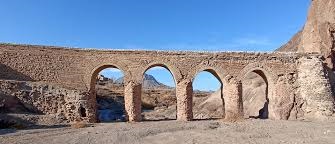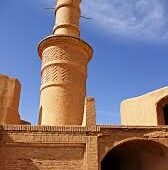Kharaq Bridge: A Timeless Engineering Marvel
p>
Kharaq Bridge, located near the historic village of Kharaq in Yazd province, Iran, is one of the most remarkable examples of ancient Persian architecture and engineering. The bridge, primarily designed for the purpose of transferring water from one side of the river to the other, stands as a testament to the sophisticated engineering techniques employed by the ancient Persians. Known for its distinctive design that blends elements of Sassanian and early Islamic architectural styles, the Kharaq Bridge is one of the oldest surviving water bridges in Iran, offering a fascinating glimpse into the past.
History and Purpose of the Kharaq Bridge
- p>
- Construction and Historical Context: The Kharaq Bridge was constructed during the Islamic era, with some elements believed to have been influenced by earlier Sassanian techniques. The exact date of its construction is debated, but it is generally thought to have been built sometime around the 7th or 8th century AD. It was built as a functional water bridge, with the primary purpose of transferring water across the Khal River (Khal Rud), providing a crucial link for the irrigation systems that supported agriculture in the region.
- Water Transfer System: The bridge was strategically built to transfer water from one side of the river to the other, enabling the creation of irrigation channels that supported agricultural activities. This method of water transfer was an essential element of Persian hydraulic engineering, enabling the arid regions of Iran to cultivate crops in areas otherwise unsuitable for farming.
- Strategic Location: The bridge’s location was carefully selected to take advantage of the natural geography of the area. Situated near the village of Kharaq, it was placed where the river was narrow enough to allow for an efficient water transfer system while also connecting the settlement to the broader irrigation network of the region.
Architectural Features of Kharaq Bridge
- p>
- Design and Structure: The bridge is a prime example of Persian bridge engineering, combining both aesthetic beauty and functional utility. The bridge is made primarily of brick and stone, with a central span supported by multiple arches that allow water to flow underneath the structure. The use of arches is not only an architectural choice but also an engineering necessity, distributing the weight of the bridge evenly and providing the necessary support for its long lifespan.
- Sassanian Influence: The design of Kharaq Bridge reflects the influence of Sassanian architecture, with elements such as the robust use of arches and the emphasis on symmetry. The Sassanian style was known for its engineering innovations, and the Kharaq Bridge is a perfect example of how these techniques were adapted for water management purposes.
- Unique Water Channel System: The bridge features a unique water channel system that allows water to be directed across the river in a controlled manner. The channel runs along the top of the bridge, with a series of openings that let water pass through in a steady stream. This system was designed to prevent flooding and ensure a constant, regulated flow of water to the agricultural fields on both sides of the river.
- Aesthetic Features: Despite its primary function as an infrastructure project, Kharaq Bridge also showcases the aesthetic sensibilities of the time. The bridge is adorned with geometric patterns and intricate brickwork that were typical of the Persian architectural style. The combination of form and function in the design of the bridge is one of the reasons it has remained an iconic structure in Persian history.
- Materials Used: The primary materials used in the construction of the Kharaq Bridge include bricks, stones, and mud, which were locally sourced. These materials not only contributed to the durability of the bridge but also reflect the resourcefulness of the builders, who made use of the materials available in the surrounding environment to create a lasting structure.
Cultural and Historical Significance
- p>
- Hydraulic Engineering: The Kharaq Bridge is a testament to the advanced hydraulic engineering skills of ancient Persians. The bridge’s design reflects the ingenuity and understanding of water management systems that were critical to the survival of settlements in Iran’s arid regions. It is an early example of how architecture and engineering were used to address the challenges posed by the environment.
- A Symbol of Persian Innovation: The bridge stands as a symbol of the creative spirit of Persian engineers and architects, who were adept at designing and constructing practical solutions to the problems faced by their society. The construction of Kharaq Bridge allowed the region to thrive agriculturally, ensuring the growth of settlements by facilitating water distribution.
- Historical Continuity: The continued use and preservation of the Kharaq Bridge reflect the enduring nature of Persian engineering traditions. Despite the passage of centuries, the bridge remains an active part of the region’s water management system, demonstrating the long-lasting impact of these ancient technologies on modern infrastructure.
- Cultural Heritage: As one of the oldest and most significant water bridges in Iran, Kharaq Bridge is a valuable part of the country’s cultural heritage. It has been designated as a national heritage site, ensuring its preservation for future generations. The bridge not only serves as an engineering marvel but also as a symbol of the rich cultural and historical traditions of Iran.
Tourism and Preservation
- p>
- A Popular Tourist Attraction: Today, Kharaq Bridge stands as a popular tourist attraction in Yazd province. Visitors come to see the ancient structure and learn about its role in the region’s development. The bridge offers a peaceful setting, with its natural surroundings and the flowing water beneath adding to its charm.
- Preservation Efforts: Preservation efforts for Kharaq Bridge have been ongoing, with the Iranian government and local authorities taking steps to maintain the structure’s integrity. The bridge has undergone several restorations over the years, with efforts focused on reinforcing the structure while preserving its original design.
- Cultural Tours: Many cultural tours of Yazd and the surrounding region include Kharaq Bridge as a key stop. Tour guides provide visitors with insights into the history of the bridge, its construction, and its importance in Persian engineering and culture. The bridge offers a glimpse into the advanced technologies used by ancient civilizations to solve practical problems.
p>
Kharaq Bridge stands as a remarkable example of ancient Persian engineering, reflecting the ingenuity and creativity of a bygone era. Its unique design and enduring functionality continue to impress visitors and historians alike. As a testament to the advanced hydraulic engineering techniques of the Sassanian era and the importance of water management in arid regions, the Kharaq Bridge remains a symbol of the Persian civilization’s ability to adapt to its environment and create lasting infrastructure that continues to serve the needs of its people.




